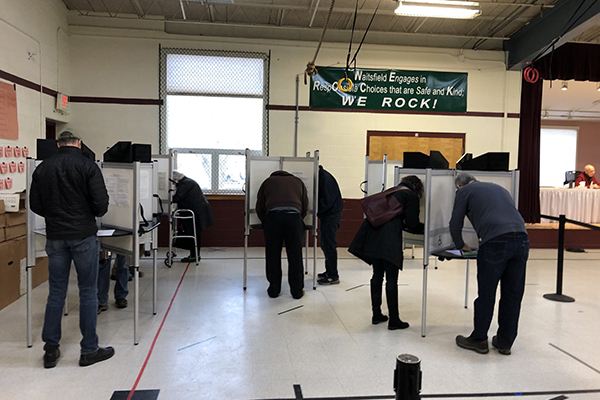The Harwood Unified Union School District (HUUSD) Board’s proposed budget of $39,770,000 was voted down by a commingled vote of 3,048 to 2,254. A maintenance reserve fund budget request for $1,880,109, also voted on via Australian ballot, passed 2,957 to 2,213.
There was a concerted local effort to encourage voters to reject the school budget as a way to let the school board know they were unhappy with plans to move all district seventh- and eighth-graders to Crossett Brook Middle School this fall (after four other board votes to reject that plan) and move Moretown’s fifth- and sixth-graders to Crossett Brook. That plan, which the school board called “rezoning,” requested installing temporary classrooms at Crossett Brook for $315,000.
The push to reject the budget was exacerbated by a federal court ruling in which the judge quoted the school board’s attorney in his ruling: “If voters disapprove of the HUUSD Board’s grade configuration plan, they can indicate their disapproval by voting against the fiscal year 2021 budget that moves forward that plan.”
School board leaders stated prior to the vote that regardless of whether the budget passed or was rejected, their plan to rezone students would remain the same. The board will meet next Wednesday, March 11, with its new members.
WHAT’S NEXT?
Asked what’s next? school board chair Caitlin Hollister said, “That’s a good question.”
“We know what a yes vote means on the budget. With a no vote there’s a lot of uncertainty. The board meets next Wednesday and welcomes three new members and we’ll decide how to proceed,” Hollister said.
Regarding whether the no vote represented voter dissatisfaction with rezoning, Hollister said it’s too hard to interpret a yes/no vote that way. She said HUUSD constituents are under intense tax pressures.
“I imagine there are many reasons for people voting no,” she said, noting that voter turnout was significantly higher this year than in prior years, which she said could be due to the presidential primary.
This year’s budget garnered 5,302 votes. In 2019, the 2020 budget received 1,929 votes. The year before that, 2018, the 2019 budget received 2,181 votes. In 2016 (a presidential primary year), the 2017 budget received 4,604 votes. 2013-2015 totals were 2,278, 2,977 and 2,242, respectively.\
SCHOOL BOARD RACES
There were contested school board races in Moretown, Waterbury and Waitsfield. In a two-way race for one seat on the Harwood Unified Union School District Board representing Moretown, Lisa Mason received 472 votes and Chris Noyes received 169 votes. They were vying for Gabe Gilman’s seat.
In Waitsfield, Christine Sullivan prevailed in a two-way election, receiving 439 votes to write-in candidate Russ Bennett’s 290 votes. In Waterbury, Kelley Hackett received 961 votes versus Michael Frank’s 817 votes in the race for Maureen McCracken’s seat on the Harwood Unified Union School District Board.
Alec Adams was elected as a write-in candidate to the school board from Duxbury.
Voters in Fayston and Warren unanimously passed a nonbinding vote of no confidence in school district Superintendent Brigid Nease.
While Warren voters were holding their Town Meeting, Warren HUUSD representative Rosemarie White stopped at Waitsfield Elementary School where polls were still open and removed a campaign sign for Bennett. Asked about it, White said, via email, that she stopped of her own accord, knowing that school Principal Kaiya Korb, wanted to keep the school property apolitical.
“I know Kaiya has a rule to keep the school apolitical and I was helping to abide by her wishes. There was a large pile of signs which had apparently been taken down earlier in the day and included signs encouraging people to vote against the budget as well as support for Bernie,” White said.
Korb said, also via email, that it was her policy to remove signs that are political and allow signs for things like the Waitsfield PTO’s Ski and Skate Sale.
“My understanding (and actions) have been that all signs on school property are at my discretion to decide about. I have not conferred with others, except for Jen Peterson, and a read of state statute regarding polling places, to make this decision,” Korb explained, referring to Jen Peterson, Waitsfield’s town clerk.
Will Senning, Vermont secretary of state elections director, said that it would be Peterson who has the authority to allow, disallow or remove signs as the presiding officer of the election/polls.
The statute reads: The presiding officer can prohibit all signs from being placed in the ground or affixed to anything on the property of the polling place. However, the presiding officer cannot prohibit a person from standing and holding a sign outside the polling place as long as the person does not hinder or impede the progress of any voter going into or out of the polling place. For the day of the election, the presiding officer can adopt a policy to allow signs to be placed in certain areas as long as the policy is applied evenly to all candidates or political issues regardless of the political content. The presiding officer can limit the size or number of signs per candidate.
VOTER TURNOUT
Voter turnout throughout The Valley ranged from a high of 58.1% to 42.4%. Valley voters overwhelmingly supported Vermont Senator Bernie Sanders in his bid for the Democratic presidential nomination. Sanders received 1,534 votes from Duxbury, Warren, Waitsfield, Fayston and Moretown. President Donald Trump received 364 (see chart).
In other Town Meeting news, voters in Warren, Waitsfield and Fayston approved a funding request for $15,000 from the Mad River Valley Recreation District as well as a request for $15,000 from the Mad River Valley Ambulance Service.







